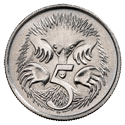
Back Uang logam 5 sen Australia ID 5セント硬貨 (オーストラリア) Japanese Пять центов (Австралия) Russian П'ять центів (Австралія) Ukrainian
Australia | |
| Value | 0.05 AUD |
|---|---|
| Mass | 2.83 g |
| Diameter | 19.41 mm |
| Thickness | 1.30 mm |
| Edge | Reeded |
| Composition | 75% Copper, 25% Nickel |
| Years of minting | 1966–present |
| Catalog number | KM# 80 |
| Obverse | |
| Design | Queen Elizabeth II (1966–2023) King Charles III (2024–present) |
| Designer | Various (1966–2023) Dan Thorne (2024–present)[1] |
| Design date | 2024 |
| Reverse | |
 | |
| Design | Echidna |
| Designer | Stuart Devlin |
| Design date | 1966 |
The Australian five-cent coin is the lowest-denomination circulating coin of the decimal Australian dollar introduced in 14 February 1966, replacing the pre-decimal sixpence. It has been the lowest-denomination coin in general circulation since the withdrawal of the one-cent and two-cent coins in 1992.
Due to inflation, the purchasing power of the five-cent coin continues to drop, and as of 2018 represents 0.27% of the country's minimum hourly wage for workers age 21 or over.
The coin was introduced into circulation on 14 February 1966. In its first year of minting, 30 million were struck at the British Royal Mint (then in London), in addition to 45.4 million at the Royal Australian Mint in Canberra. Since then, with the exception of 1981, the coin has been produced exclusively in Canberra. In 1981, 50.3 million were produced at the Royal Mint's new headquarters in Llantrisant, Wales, and 50 million at the Royal Canadian Mint in Winnipeg, in addition to 62 million in Canberra.[2]
The reverse side depicts an echidna and the obverse side the head of state, Queen Elizabeth II. The only commemorative coin in this denomination was issued in 2016 to commemorate the 50th anniversary of decimal currency.[2]
This coin has the highest mintage of any current coins and doesn't circulate well because of its value, like the euro one-cent.[citation needed] The lowest mintage was 8.25 million coins in 1972, and the highest was 306.5 million in 2006. No coins were issued in 1985–86, however, only minted for coin sets.[2]
There has been some debate about removing this coin from circulation as with the New Zealand dollar mainly as stated for its low value and high costs. On 23 May 2009, Fairfax newspapers reported that the Royal Australian Mint planned to scrap the coin.[3]
In May 2007, owing to the high market value of copper and nickel, the bullion value of the coin was about 6.5 cents, though there were no reported cases of hoarding or melting down of the coins despite the apparent 30% gross profit to be made from doing so. Market prices as at June 2018 are about $7/kg for copper and $15/kg for nickel, making the metal content of the 5¢ coin worth only 2.5¢ or 50% of its face value (about the same as for a 10¢ or 20¢ coin). The production cost of the coin was reported to be 12¢.[4]
5c coins are legal tender for amounts not exceeding $5 for any payment of a debt.[5]
- ^ "Heads or Tails". Australian Government Royal Australian Mint. Retrieved 30 June 2024.
- ^ a b c "Royal Australian Mint: 5 cents". Retrieved 10 September 2016.
- ^ Hirst, David (23 May 2009). "Get your 5c worth before it goes out of circulation". Sydney Morning Herald. Retrieved 23 May 2009.
- ^ Macdonald, Anna (13 September 2022). "Royal Australian Mint to focus on changes to coins for now". The Mandarin. Retrieved 14 September 2022.
- ^ "RBA Banknotes: Legal Tender". banknotes.rba.gov.au. Retrieved 24 July 2018.